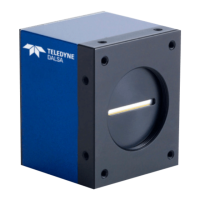Spyder3 SG-34 GigE Vision Color Manual 27
Teledyne DALSA 03-032-20124-00
Verify Temperature and Voltage
To determine the voltage and temperature at the camera, use the Read Voltage and Temperature feature
found in the Camera Information set.
The temperature returned is the internal chip case temperature in degrees Celsius. For proper operation,
this value should not exceed 80 °C. If the camera exceeds the designated temperature it will shut down
and w ill not tu rn on until the cam era’s tem perature is 73 ºC or less. Use the reset camera function.
The voltage d isplayed is the camera’s inp u t voltage. N ote that the voltage measurem ent featu re of the
camera provides only approximate results (typically within 10%). The measurement should not be used
to set the applied voltage to the camera, but only used as a test to isolate gross problems with the supply
voltage.
Saving and Restoring Camera Settings
The parameters used to select, load and save user sets are grouped together under the Camera
Information set of features.
GigE Vision Input Controls
User Set Selector / Device Configuration
Selector
Selects the camera configuration set to load feature settings from or
save current feature settings to: factory (default) or user sets.
The Factory / Default set contains default camera feature settings.
User camera configuration sets contain feature settings previously
saved by the user.
User Set Load / Load Configuration
Load the set specified by User Set Selector to the camera and make
it the active / current set.
User Set Save / Save Configuration
Save the current set as selected user set.
Description of the Camera Settings
The camera operates in one of three settings:
1. Current session
2. User setting
3. Factory setting (Default, read-only)
The current settings can be saved (thereby becoming the user setting) using the User Set Save parameter.
A previously saved user setting (User Set 1) or the factory settings can be restored using the User Set
Selector and User Set Load parameters.
The relationship between these three settings is illustrated here and described below:
All manuals and user guides at all-guides.com

